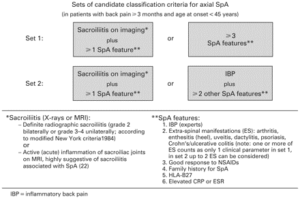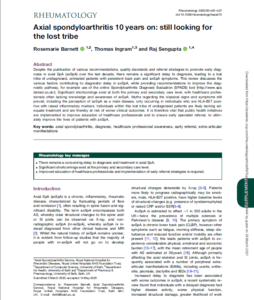
READ HERE
The development of Assessment of SpondyloArthritis international Society classification criteria for axial spondyloarthritis (part II): validation and final selection.
Rudwaleit M, van der Heijde D, Landewe R, Listing J, Akkoc N, Brandt J, et al. The development of Assessment of SpondyloArthritis international Society classification criteria for axial spondyloarthritis (part II): validation and final selection. Ann Rheum Dis. 2009;68(6):777-83. https://ard.bmj.com/content/68/6/777
It is important to note that, as discussed above, such classification criteria are not intended for use in diagnosis – the primary objective of classification criteria is to identify a homogenous population for clinical trials and research, whereby patients are similar in terms of clinical characteristics. However, the 2009 Assessment of Spondyloarthritis International Society (ASAS) classification criteria were seminal in that they formally recognised the concept of nr-axial SpA – placing emphasis on early disease and use of MRI to identify early inflammatory changes, to allow for earlier detection of patients with the condition and inclusion of patients with nr-axial SpA in clinical trials.



